Do you feel restless when you try to meditate or unwind? Then don't miss this guide on how to practise self-care with needle felting!
Most people understand nowadays that self-care is important. It is well-known that exercise, yoga, meditation or being in nature can help you cope with stress. However, it is still less recognised that arts and crafts can be just as effective. They usually get categorised as hobbies that don't have any benefits. But crafting is self-care!
Let me show you some simple steps on how to practise self-care with needle felting.
What is needle felting

In case you're not familiar with needle felting, it is the process of turning wool into different 3D sculptures, decoration pieces or 2D art with the help of special needles that have notches along its shaft. When the needles are being poked into the wool the notches catch the fibre and tangle them with other fibres. The possibilities of what can be created with needle felting are endless.
Why needle felting is a good self-care activity
Needle felting (and other kinds of crafts too) can be easier for someone who is just beginning to take time for self-care. Why? Simply, because most of us can find it hard not to do something productive because it is usually perceived as idling. No wonder that many people find meditating hard to do. For them simply sitting and not doing anything can be even more stressful.
And the reason of that is simple: they haven't learned how to slow down. Because in order to relax and practise self-care, first you need to slow down. Needle felting can help you get over that initial obstacle of "not doing anything". The repetitive movement of the needle will give you two things:
Needle felting can help you enter the flow state
The flow state, also known as 'being in the zone', is the perfect mental state in which you can let go of all of your worries and problems. You can relax, feel energised and good about yourself while concentrating intently on the task at hand. This is exactly what we want to get out of a relaxing needle felting fun.
Read more about how needle felting can help you cope with stress and reduce anxiety in the 'Relieve stress with needle felting' post.
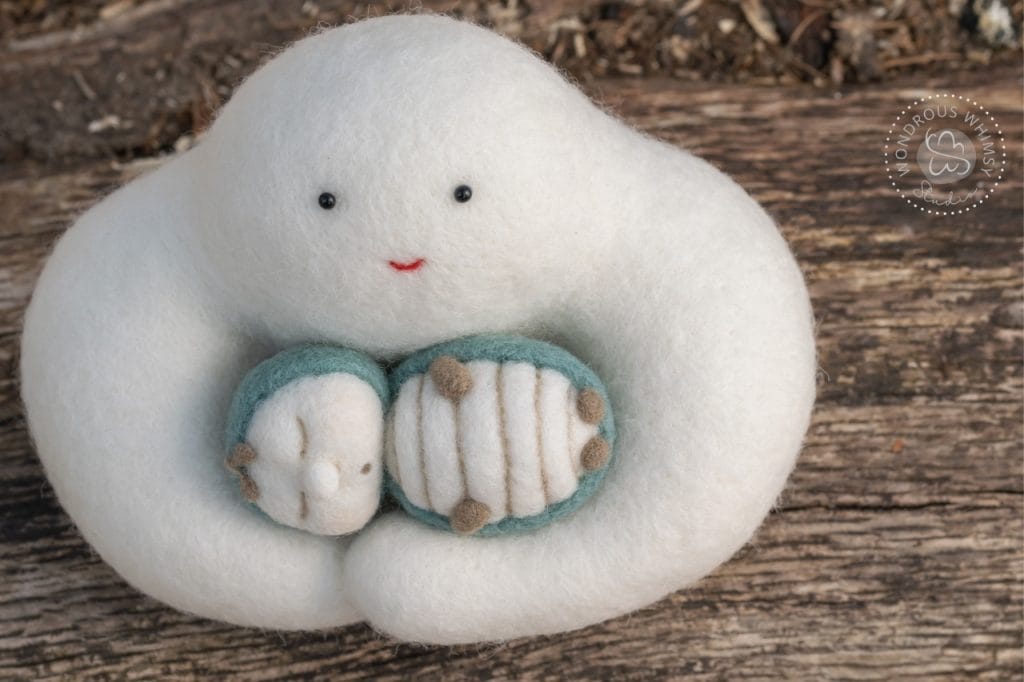
How to practice self-care with needle felting
STEP 1: Embrace slow crafting
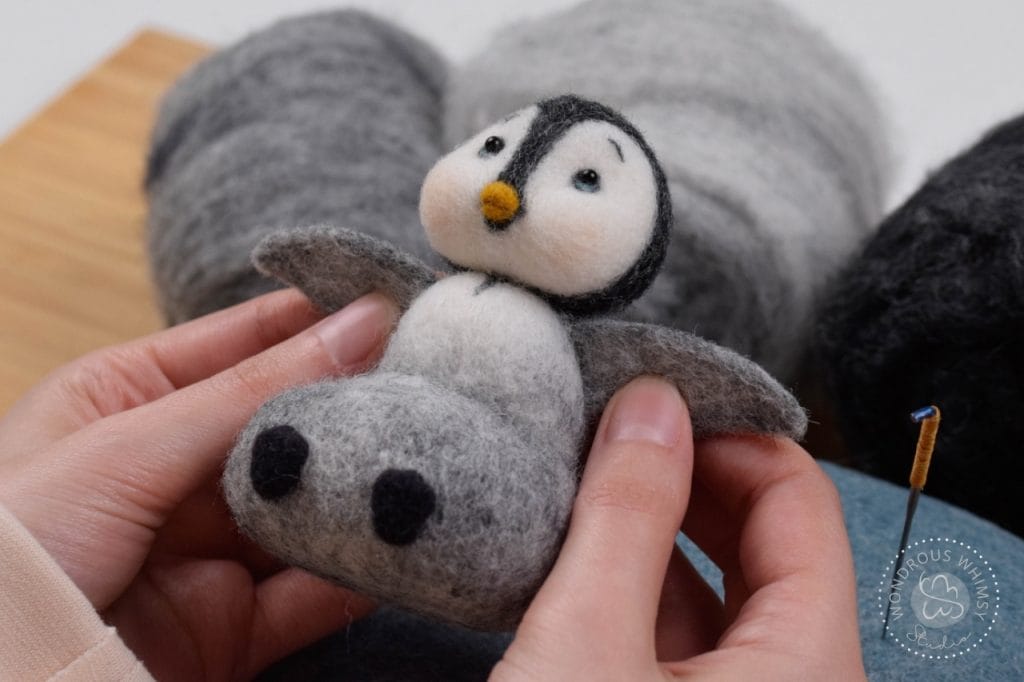
Those who love crafting know that even a short time - say 15-30 minutes - spent on our favourite craft can make us feel good. It can make us smile and make us think that 'yes, I did some crafting today'. But, unfortunately, it won't really help if the goal is self-care, relaxation and reducing anxiety.
What short and fast projects can give us is a hit of dopamine which will quickly wear off. They can't help us get 'in the zone' and be absorbed in a project.
Being able to fully focus on an activity without noticing any kind of distraction - not even the need to eat or drink - is one of the conditions that needs to be met if we want to enter the flow state. That is hard to accomplish within 15-30 minutes, especially if someone is just starting out.
If your purpose is to calm down and let go of your worries and the stress of your lives, slow crafting is the way to go. Needle felting is a perfect example of a slow craft. It takes time and even beginner projects can require an 1-3 hours of your time (or even more).
STEP 2: Choose your needle felting project carefully

Saying that you should choose a needle felting project that you like may sound obvious, but please bear with me because there are some hidden traps you might fall into!
When we choose a project we go through several options that we see, and usually settle for the one we prefer most. However, crafting and more specifically spending time on crafting can make people feel that it is an indulgence. They may also feel that it is something to apologise for, something to feel guilty about or even be ashamed of.
The culprit is the 'modern' perception of crafting as a mere hobby. In this sense, you can do it only when you have finished all of your other important tasks since that is when you deserve it!
Even if you may not acknowledge this consciously, this idea is usually in our head lying beneath the surface. It could influence every decision in connection with your crafting choices and even the outcomes. To avoid any bad feelings try to keep the following tips in mind.
TIP #1: YOU need to love the project you choose and no-one else
Choose a project that you like because it makes you feel something. In this way you can avoid choosing something that you think you should do. To see what I mean, here's an example.
Let's say that your family likes realistic and life-like art. You spot two different needle felting projects. One about how to make a more stylised beautiful doll, and one about how to make a realistic sunflower out of wool. You may like the sunflower as well, but what actually makes you feel good - for any reason - is the doll. In a situation like this, it can happen that you'll end up choosing the sunflower because you think that is expected of you.
Do you see what I mean? Needle felting is for you and for your benefit only. You do not need to please anyone else with your projects!
TIP #2: Avoid the productivity trap
Choose a project that you think could be fun to try regardless of the outcome. In this way you can avoid choosing a specific project that you think can prove that you spent all that time productively. In our day and age, productivity is glorified and can make people think that they have to be productive all the time to be happy and satisfied.
However, when you want to practise self-care with needle felting productivity does NOT matter.
The desired outcome of a successful needle felting self-care fun is not the perceived quality or value of the end result. Your success is measured by how calm, energised and satisfied you are.
For example, if you really like a project that shows you how to make a simplified minimalist dog statue that looks easy, go for it! Do not choose a more detailed project of a dog just because you think you need something to show for the time spent on making it.
STEP 3: Make sure your project meets the conditions needed for the flow state
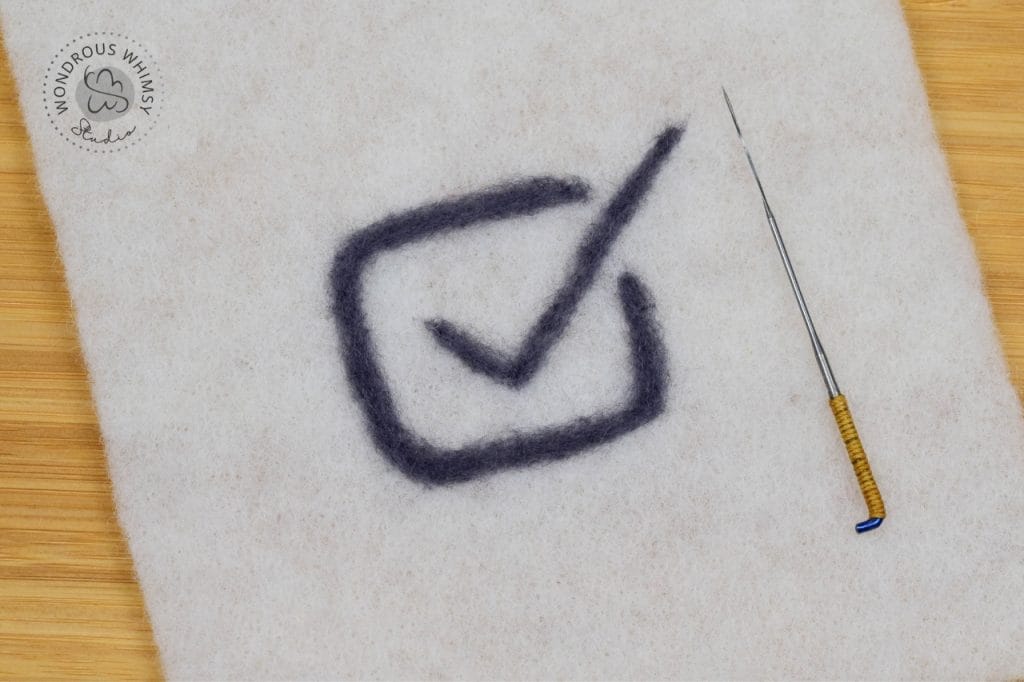
There are four main conditions (other than the already mentioned length of the project) that need to be met if you want to get in the zone. They are also important if you want to make sure that you stay in the flow state.
STEP 4: Create a warm-up ritual for practising self-care with needle felting
I know that this point may be something of a surprise to you. But warming up for a needle felting self-care activity can help you slow down and relax sooner.
This warm-up practice is based on my own experience and not backed up by science like the flow state. So, it's up to you whether you accept this advice or not. However, I think it's worth giving it a try and even creating your own routine.
I first got the idea of the warm-up practice from a book entitled The Power of Habit by Charles Duhigg. He mentions that if we want to form a new habit, it's a good idea to use a cue that signals to our mind that a specific activity is about to happen. In this way we can slip into the required mindset more easily and performing the activity won't be such a challenge.
How it could look like
Many creative people - for example, writers, painters, designers etc. - use some sort of a cue or "ritual" before they begin creating. For some this could be as simple as brewing a cup of tea first and placing it on the same spot on the desk each time. Then, sitting down in a comfortable chair. In the same one each time. All of it is not just preparation but can also give you and your activity a sense of continuity.
If the craft is painting, then the next step is placing a new piece of watercolour paper on the desk. Then, the same watercolour paint palette with the favourite brushes.
Doing it mindfully means that the mind does not wander but stays in the present. For some it's enough to look at the objects on the table to do that, for some a longer physical contact is necessary.
The idea behind such a ritual is that the actual activity - in our case needle felting - does not start only when we first start poking a ball of wool, but minutes before that, by the preparation. It could be especially useful if you truly want to relax and practise self-care with needle felting.
So, now I'm going to describe what I do. You can also try it, but I urge you to create your own ritual that best suits your needs and personality.
My warm-up ritual
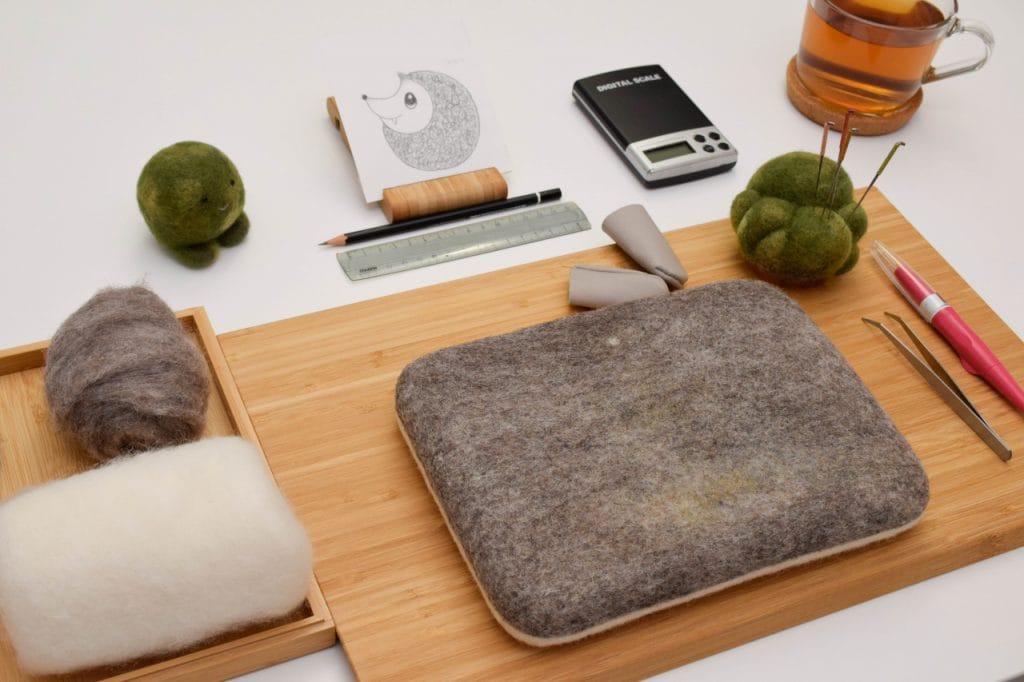
While my Earl Grey is brewing, I put everything else away off my desk. Then I place everything I need and want to use that day on my desk, including the sketch of that day's project. I always put all my tools in the same place - it always feels like continuity and helps me get into the same mindset more easily.
When my tea is ready it goes into its usual place, like everything else. Its smell always makes me want to take a deep breath, so I do just that before putting it on the desk: a long inhale and exhale.
Before I sit down, I stretch my arms upwards and take several more deep breaths, look at my prepped desk and smile.
When I sit down, I take a lump of wool - the one I intend to start with that day - and concentrate on how it feels between my fingers, how warm it is, how smooth it is and so on. That is how I connect with the material I am going to use. Also, this is the moment when I always remind myself to let go of perfectionism (which I struggle with) and to let go of the notion of being productive.
Now, all of this does not take long, maybe 5 or 10 minutes. Also, depending on the project I am about to work on, I sometimes choose to listen to music or an audiobook or just work in silence.
What to pay attention to when creating your own warm-up ritual for your self-care practice
Your ritual can be completely different and that's okay. However, try to focus consciously on a couple of things as they can help you get in the mood more quickly or can help you slow down more easily if you have done something faster previously.
All of this can help you be mindful and feel purposeful when you practise self-care with needle felting. Enjoy!
STEP 5: Plan your needle felting time ahead - think about it as a mini retreat
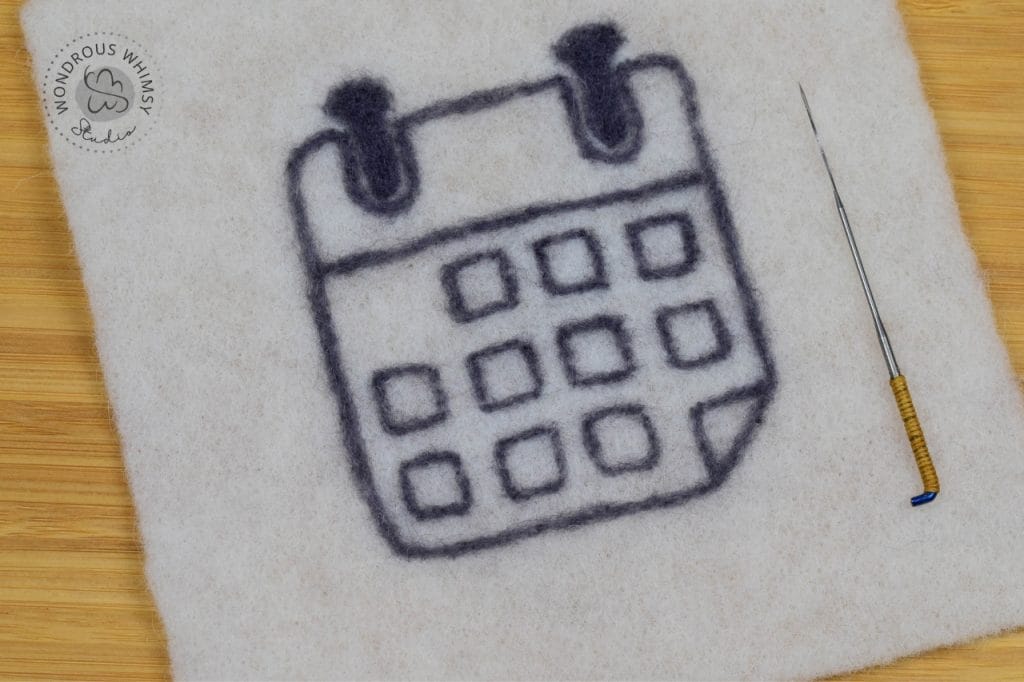
You need the space, time and mindset so you can practise self-care with needle felting successfully. To accomplish that, it is a good idea to plan ahead and decide when you want to do it. Remember, we don't talk about 15-30 minutes, but a longer time period, at least and hour or an hour and a half or even longer.
You know your schedule, so I'm not going to talk about how to find the time here. You can read about my advice in the post 'How to find time for needle felting (and other crafts)'.
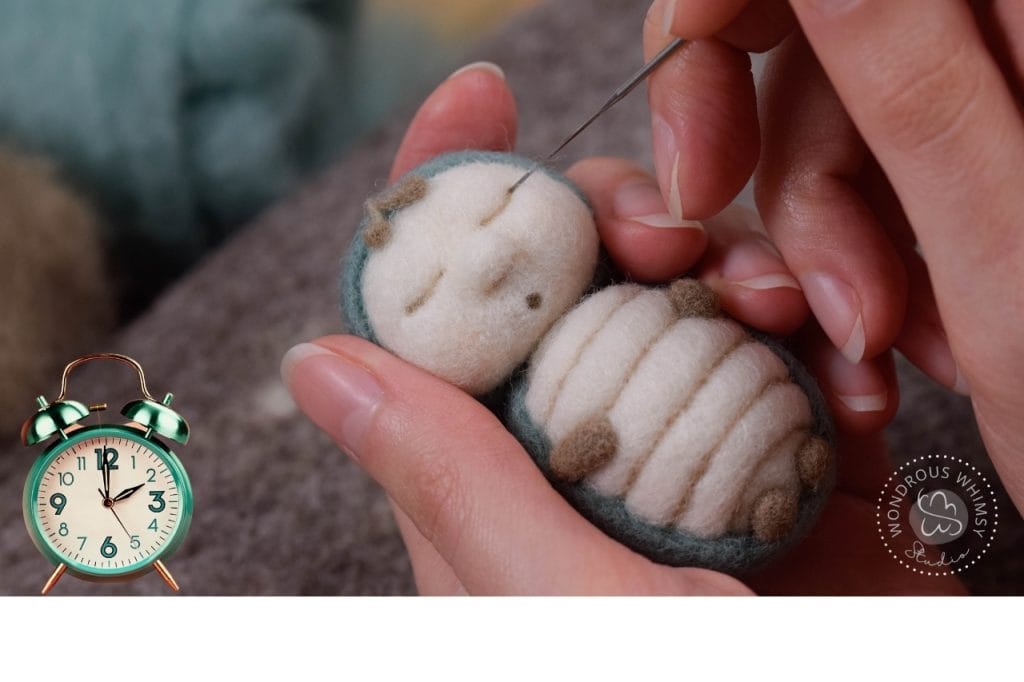
Any kind of self-care takes time and some forms of practice can require a longer time. If you want to go to a group yoga session, for example, and you need to drive there and back, you already know that you need at least 1.5 or 2 hours to do so. The same is true for needle felting, without the added stress of driving.
When you plan where, when and how you are going to practise self-care with needle felting, think about it as a mini retreat. Think about what you need, as in materials and tools, space and conditions. Make sure that the time is yours only and minimise the possible distractions as much as you can.
Later on, if you want to needle felt with kids, friends or family that's fine, but self-care is about you and only you! You have permission to take care of yourself!
Regularity is key
In order to reap the benefits of needle felting as a self-care tool, you have to make it a routine. Just like with everything else in life, only regular practice of this slow craft will make a difference.
The same way one healthy dish won't help you lose weight, one needle felting mini retreat also won't lower your stress level forever. It's worth thinking about how you can build it into your weekly or monthly routine. One 2-3-hour-long practice at the weekend? Or maybe a longer session twice a month or once a month?
Are you ready to use needle felting as a means to relax?

Needle felting as a slow craft is one really good way to help you practise self-care. Slowing down is key if we want to reduce stress and anxiety in our life, and this awesome craft can help you learn how to do that.
The steps and conditions mentioned don't represent a one-size-fit-all way of how to relax with your needle felting project - or with any other crafting project for that matter. However, in my experience they can highly contribute to the positive outcome of a crafting time if your goal is self-care.
Are you ready to give it a try? Do you have your own needle felting self-care tips? Let me know in the comments below?
Happy felting!

0 comments